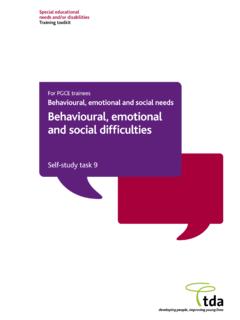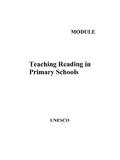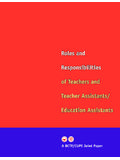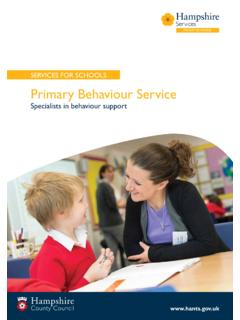Transcription of Classroom Management Strategies for ADHD in …
1 LANC 1 Classroom Management Strategies for adhd in Secondary School adhd in High School: Setting Up the Classroom Since adhd students are usually easily distracted and easily bored, it is a good idea to set up your Classroom in such as way as to optimize their focus, and increase their chances of success. o The best ideas are the ones that benefit all of the students in the Classroom , not just the adhd students. o With your adhd students it is usually better to use rows in your seating arrangement and to avoid groups of students. Often the groups are too distracting for the adhd student. o In the ideal setting, provide tables for limited and specific group projects, and traditional rows for independent work.
2 O Some teachers have suggested arranging desks in a horseshoe shape to promote appropriate discussion while permitting independent work. o Teachers must be able to move about the entire room and to have access to all students. Practice " Management By Walking Around" in your Classroom . o Make eye contact with your students, especially those with inattentive adhd . o Have your adhd students seated nearest to the place in the class where you will give directions or lectures. Seat them as close as possible without being punitive to them. o Do not seat adhd students in the back of the Classroom . To minimize distractions, seat attention deficit students away from both the hallway and windows.
3 O Stand near attention deficit students when giving directions or presenting the lesson. Use the adhd student's worksheet as an example when you are giving the directions. o Make sure that the attention deficit students know what's going on around them. o As best as you can, provide comfortable lighting and room temperatures. o Raise your expectations for their performance, and let them know what your expectations are. Let them know that you believe that they can succeed in your Classroom , but there will be a price to pay in terms of effort and organization. Let them know that you will help as much as possible. Presenting Your Lesson to adhd Students o Provide an outline with the key concepts or vocabulary prior to lesson presentation.
4 The students can follow along and see the main concepts and terms as you present the lesson. o adhd teens are easily bored. Try to increase the pace of lesson presentation. Resist the temptation to get sidetracked. o Include a variety of learning activities during each lesson. Use multi-sensory presentations, but screen audio-visual aids to be sure that distractions are kept to a minimum. For example, be sure interesting pictures and or sounds relate directly to the material to be learned. LANC 2 o Many teachers are now using PowerPoint presentations or Astound presentations for their students with great effect. o Provide self-correcting materials for immediate feedback to the adhd student.
5 O Use computer assisted instruction, both in terms of the student at a computer, and also in terms of presenting information via PowerPoint presentations. o Use cooperative learning activities, particularly those that assign each teen in a group a specific role or piece of information that must be shared with the group. o Pair students to check work. o Provide peer tutoring to help adhd student's review concepts. Let students with Attention Deficit Disorder share recently learned concepts with struggling peers. Use peer tutoring whenever possible. Use older students to help your attention deficit students, and perhaps allowing him to tutor a younger student. o The more exciting a subject is to a student with Attention Deficit Disorder, the better he will perform in your class.
6 Let your students know "why" learning your material is important! Motivation is key. Tips for Using Worksheets and Giving Tests to Students with adhd Students with adhd can really benefit from well thought out worksheets, and from tests with modified structures. For example, many students with Attention Deficit Disorder do very poorly on timed tests, but will do just fine on the same test without a time limit imposed. o "Usability" is essential. Just as web designers strive to make web sites fast, easy to navigate, and more user-friendly, teachers should strive to make their worksheets easy to understand, easy to navigate, and user friendly. o Use large type. o Make the important points easy for the student to find.
7 O Keep page format simple. o Include no extraneous pictures or visual destructors that are unrelated to the problems to be solved. o Use buff-coloured paper rather than white if the room's lighting creates a glare on white paper. o Write clear, simple directions. Underline key direction words or vocabulary or have the students underline these words as you read directions with them. o Draw borders around parts of the page you want to emphasize. Draw their attention Giving Tests to adhd Students o Frequently give short quizzes and avoid long tests. o adhd students are well known for doing poorly on long tests or on timed tests, even when they know the material. o Provide practice tests.
8 O Provide alternative environments with fewer distractions for test taking if necessary. Students with attention deficit will often perform much better is taking a test in a quiet environment with few distractions. LANC 3 o Using a tape recorder, have the student record test answers and assignments or give the student oral examinations. o Consider modifying the test environment for students with Attention Deficit Disorder to accurately assess their ability/achievement on subject area and standardized tests. Individual administration in a quiet area with frequent breaks will give a more accurate assessment than group administration. Impulsivity with adhd Students adhd Attention Deficit Hyperactivity Disorder is generally defined by: Inattention, Impulsivity, and sometimes Hyperactivity.
9 Impulsive behaviours are common. One of the main characteristics of people with Attention Deficit Disorder is the tendency to act impulsively (acting before thinking about the consequences of their behaviour). Impulsivity often shows itself in a lack of understanding of cause and effect. Research suggests that adhd students can often verbalize the rules but have difficulty internalizing them and translating them into thoughtful behaviour. Difficulties in waiting for what they want also add to the impulsivity. Some clinicians believe that this lack of "self-control" (poor regulation and inhibition of behaviour), rather than their problems with paying attention, is the primary problem with attention deficit disorder.
10 O Give your adhd students a break once in a while. o Know the difference between big things and little things, and don't confront attention deficit students on each little thing. It is hard for adhd students to control themselves all of the time. o Distinguish between premeditated and impulsive behaviours. Consequences still need to be applied in both situations but telling a student who has been impulsive that you realise it was impulsive can help him/her feel more understood. o By having attention deficit students think "out loud" when they are problem-solving, the teacher will gain insights into their reasoning style, and the process will slow them down before they respond impulsively.






